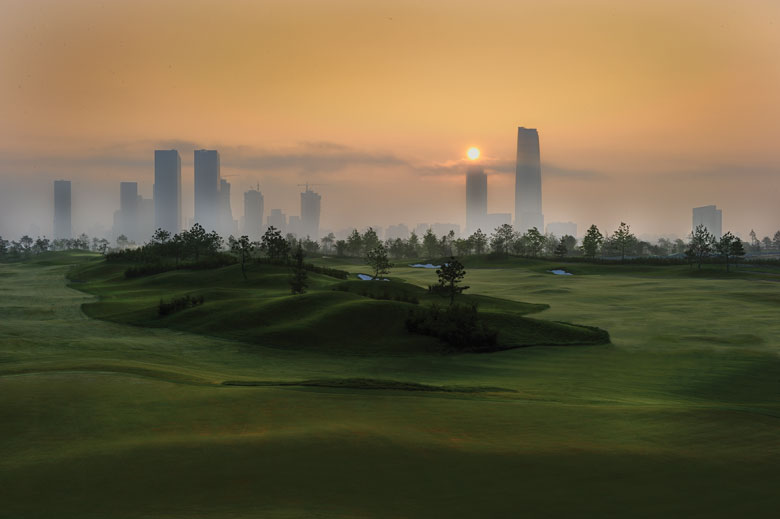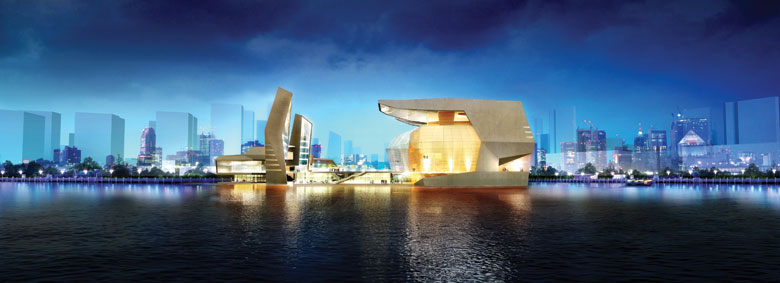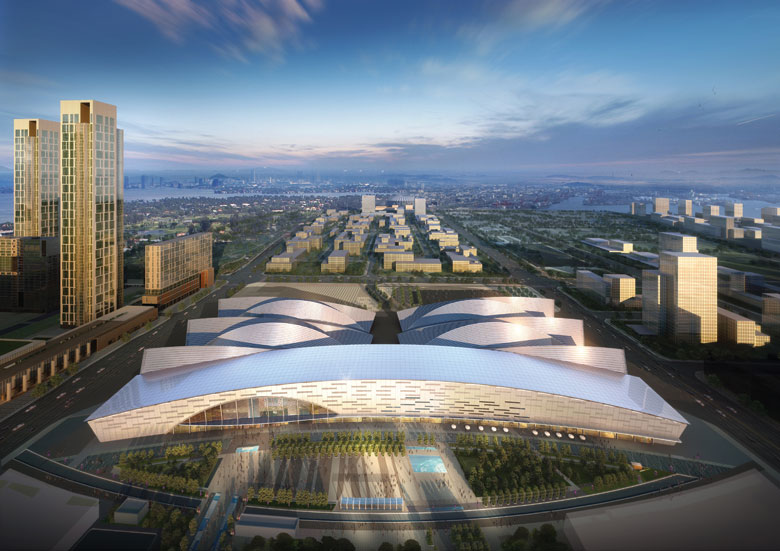Smart technology, serious eco credentials and a very Korean dance craze – welcome to the world’s new aerotropolis, says Jenny Southan
Zipping along the 12km bridge from Incheon airport in the glare of the early morning sunshine, I watch as the hazy blue skyline of Songdo comes into view. Ten years ago, much of the real-estate this metropolis is built on was under the Yellow Sea, while the rest was tidal flats – the preserve of migratory wader birds and fisherman.Since then, a fast-moving land reclamation project and a mammoth US$35 billion investment by developer Stan Gale has transformed it into the world’s first smart, sustainable aerotropolis, complete with its own version of New York’s Central Park, a Jack Nicklaus-designed golf course and the tallest tower in the country.

I meet Scott Summers, vice-president of foreign investment and marketing for Gale International, in the lobby of the Sheraton hotel. In the same breath as introducing himself, he asks if I want to come outside and see the president of South Korea. He then rushes me across to the Convensia congress centre (modelled on the Sydney Opera House) and points to Lee Myung-bak and his black-suited entourage as they walk briskly by.
It happens to be an unexpectedly important day for the city as it has just won the bid to host the United Nation’s Green Climate Fund (GCF), the biggest international organisation the country has ever been home to. Up against five other cities (Bonn, Geneva, Mexico City, Warsaw and Windhoek), the vote to relocate 500 UN employees and their families out here, as well as providing the hub for global climate change finance, couldn’t be more perfect for a metropolis that has been designed to be eco-friendly. “Everything was built with a green philosophy behind it, and to have it go full circle with the GCF is fantastic,” says Stan Gale. What’s more, the economic impact will be huge. “It’s bigger than winning the Olympics,” Summers says.
Not only is Songdo the largest private real-estate venture in history, but its environmental credentials are impressive – the buildings that make up the 6 sq km international business district (IBD) are all certified by LEED (Leadership in Energy and Environmental Design), there are 25km of bike lanes, “vegetated green roofs to reduce storm water run-off”, a waste collection system that sucks rubbish directly from homes, and 240 hectares of natural space, including the 40-hectare Central Park (complete with deer). All in all, it is designed to emit a third of the greenhouse gases typically produced by an urban centre of its size.

The IBD and greater Songdo (at 53 sq km in total) make up one-third of the government’s Incheon Free Economic Zone, along with nearby Cheongna district (focusing on leisure and tourism) and Yeongjong island, which will be a fully fledged logistics centre by 2020. The first stage of Songdo’s development was completed in 2009, at a cost of more than US$10 billion, and since then the IBD has become home to 20,000 people. By 2016, it is expected to accommodate 70,000 residents and 300,000 workers.
The responsibility of designing the city went to US architectural firm Kohn Pedersen Fox, and even though the project won’t be finished for another few years, there is an impressive number of gleaming, marine-green skyscrapers, including the superlative 68-storey North East Asia Trade Tower.

From the convention centre, Summers and I cross the 12-lane road to the sweeping saltwater canal that runs alongside Central Park. Families are out rowing boats, and the riverbank is jammed with people who have come for the three-times-yearly charity flea market. We manoeuvre our way through the toddlers, pushchairs and miniature dogs – some of whom sport tufts of fur dyed purple and pink.
At the main plaza, I find people pedalling bicycles that are generating electricity to power candy floss machines, and on the far side is a stage where a group of teenage boys are dancing to pop phenomenon Gangnam Style – when it was released in the summer, it became the first Korean song to make it to number one in both the UK and US charts. The video was shot in Songdo, with scenes filmed in the metro and the nearby 2,700-space subterranean car park. It may be the jet lag, but it all seems rather surreal.
I stop to talk to some of the expats manning the stalls. Kelly and Mark Hevland moved from Oregon in August 2011 and are selling some of their son’s old clothes. Kelly teaches at Chadwick International school and Mark is a stay-at-home dad to nine-year-old Grant. “Songdo is hugely different to back home so there was a big transition to make. Sometimes the weekends are quiet. Last year you would walk around and it was dead – almost eerie. They’d film commercials and movies in the middle of the street because there were no cars. But since then we have had more restaurants opening and there is more going on,” Kelly says.
Mark adds: “It’s almost creepy safe – people leave their doors unlocked and I could let my kid rollerblade in the park alone and he’d be fine.”
Housewife Maria Boelter-Emmert moved to the city from Bremen in 2010 with her husband, who works for Mando Hella, a German automotive supplier headquartered here. “When we arrived there was nothing. The roads weren’t finished, the park, those houses,” she says, pointing. “This city is growing very quickly. In Germany you need to talk to so many people to get planning permission but in South Korea, if you have the land, you can build on it.”
At the First World residential tower, next to the Sheraton hotel, I take the lift up to Stan Gale’s penthouse apartment to find out what else he has in store. The views are magnificent, and I can see patches of fenced-off land being bulldozed ready for yet more buildings.

“My greatest fear is that Songdo will be a sterile, boring city so we still have a number of signature ‘quality of life’ projects to be done,” he says. These include a hospital, arts centre, Lotte mall and US$1.2 billion waterfront project, all of which should be ready by 2015. By 2018, a super-fast train will connect Songdo with Seoul in 30 minutes.
One of Songdo’s biggest selling points is that it is an aerotropolis – only 20 minutes’ drive from Incheon airport, it is connected to more than one-third of the world’s population within 3.5 hours’ flight time. “You could go to Shanghai and back in a day,” Gale says. And as a planned “prototype” city, setting up home or office here is proving very appealing.
“The interest in our housing from Koreans is higher than anywhere else in the country,” Gale says. “No one can build a trashy building next door and your view will be retained as no one will be allowed to build in front of you. If people have to walk more than 12 and a half minutes then they will drive, so your office is within walking distance of your apartment.”
With grade A commercial space available for up to 47 per cent less than in Seoul, as well as the tax benefits that come with being located in a free economic zone, Songdo has already attracted companies such as BMW, Boeing, IBM, Johnson and Johnson, Samsung and Tesco, with key areas of industry including research and design, biotech, IT and light manufacturing. Education is also big business here, says Summers, highlighting its six public schools and five university campuses, including Washington’s George Mason and New York’s SUNY Stonybrook.
Security giant ADT moved its R&D centre from Seoul to Songdo in summer 2012. Brad Buckwalter, its president and regional general manager, says: “My objective was to get twice the space and better facilities for my money. But also because it is quiet, as that is the kind of environment you need to put your engineers in to improve their performance, and there is a lot of growth, as it is the gateway to north-east Asia. When we develop a product, we need to be able to export them to other markets.
“So far, we are glad to be here and morale is high. When you are in Songdo, you don’t feel you are in Korea – you have the ocean, the wide streets, people can cycle to work, which is unheard of in Seoul, and if you look at the tall buildings over the greenery, it looks like Singapore.”

Three years ago, telepresence company Cisco signed a deal with Gale International to wire every one of Songdo’s homes, schools and offices with an intelligent network of cutting-edge video-conferencing systems. At its Global Centre of Excellence, I am given a sneak preview of the innovations it is showcasing – from virtual concierges to distance health diagnoses.
One controversial concept is the “integrated operations centre” that could be used to monitor public safety. The “Innowatch” mock-up comprises a bank of screens and computers that link to CCTV cameras in every street, car park, station, shop, office and even apartment so the police can spot crimes and accidents. It could also be used to track missing children by tracing the GPS signal in their phones.
It all seems very Big Brother, but I am assured it is not about invading people’s privacy but about creating the safest, most efficiently run community possible. Cisco telepresence systems are fitted in numerous homes, workplaces and schools, and Gale says that by 2018 it expects 10,000 units to be installed.
Marc Musgrove, global communications director for Cisco says: “Many apartments will have this technology plumbed in from scratch. Songdo has gone against the typical approach of installing technology as an afterthought. We figured out an architectural blueprint for the city in terms of the network infrastructure and IT capability. It’s about redefining the way a city should be operated with technology at the heart of it, and once we have this down we can use it as a model for future city development.”

As populations boom, we will no doubt see similar flat-pack smart cities popping up. Yet reminders of the area’s agricultural heritage can still be seen in Songdo – as Summers drives me through the IBD, I observe a sizeable stretch of allotments, where cabbages and onions grow. “This is the land we gave back to the displaced fisherman,” he said. It looks incongruous next to the high-rise blocks, yet is indicative of the on-going struggle between old and new.
Despite a construction slump during the economic crisis, progress continues. Tom Murcott, Gale’s executive vice-president for global foreign investment, says: “Songdo provides a platform that is replicable. The development process can be condensed so the product can come out faster. People can be living there sooner and getting jobs and returning benefit to the local economy.”
Gale says China alone needs 500 Songdo-type cities to cope with demand, so it is no surprise that the company has already started work on a second state-of-the-art eco city – Meixi Lake in China’s Changsha. Meanwhile, Cisco is busy wiring up metropolises around the globe – from Barcelona to Lake Nona in Florida.
Visit songdo.com
Songdo in numbers
- US$12 billion Amount invested so far
- US$35 billion Anticipated investment
- 2004 Construction began
- 2016 Construction complete
- 15km Distance from Incheon airport
- 6 sq km Land area
- 2.4 sq km Natural space
- 40 hectares Size of Central Park
- 25km Total length of bike lanes
- 20,000 Residents now
- 70,000 Residents when complete
- 300,000 Workers when complete








